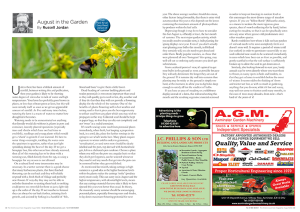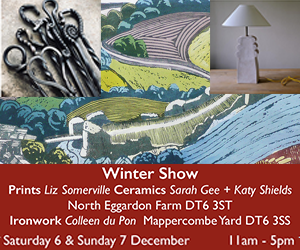
Unless there has been a biblical amount of rainfall, between writing this and publication, then your garden is likely to be showing some degree of stress due to lack of water and high temperatures. Your lawn has probably gone brown in places, or less than vibrant green at least, but this will soon remedy itself as soon as we get an appreciable amount of rainfall. As I’ve said many times before, watering the lawn is a waste of water no matter how droughted it becomes.
Watering needs to be concentrated on anything that literally would die without it; plants in pots and container, recently planted specimens (especially trees and shrubs which have not had time to establish), seedlings and young plants which would get a ‘check’ in growth if not watered. It’s best to water things overnight, trickling the water onto the specimen in question, rather than just light sprinkling during the heat of the day. If we get a hosepipe ban, like other areas have already received, then all of this watering has to be done with a watering can, filled directly from the tap, as using a hosepipe for any reason is not allowed.
On a cultural level some intervention may be necessary. In a wetter summer there is a good chance that many herbaceous plants, that have finished flowering, can be cut back and they will reliably respond with a fresh flush of foliage and probably new flowers. If very dry they may not be able to reclothe themselves so cutting them back to nothing could prove too stressful for them so just a light tidy up is the order of the day. If wet weather is forecast they can always be cut back further, initiating fresh growth, and assisted by forking in a handful of ‘fish, blood and bone’ to give them a little boost.
Dead-heading of summer bedding plants and tender perennials is even more important than usual as they will quickly go to seed in hot, dry, weather and if they do that then they will not provide a flowering display for the whole of the summer. One of the benefits of plants flowering well in hot weather and setting seed is that it gives you the best opportunity to collect seed from any plant which you may wish to propagate in this way. Collected seed should be kept in paper bags, so that they can dry out completely and not ‘sweat’ in a sealed container.
It’s worth sowing some seed from perennial plants immediately, when fresh, but keeping a proportion back, in a cool, dry, place for further sowings in the spring to see which works best. Many plants require exposure to winter cold in order to germinate, ‘vernalisation’, so seed sown now should be clearly labelled and the pots, top dressed with horticultural grit, left in a sheltered spot outdoors. Choose a place where you will see the pots on a regular basis so that they don’t get forgotten, can be watered whenever they need it and any weeds that get into the pots can be removed before they get established.
As mentioned last month, taking cuttings in high summer is a good idea as the higher hormone levels within the plants makes the cuttings ‘strike’ (produce roots) more easily. This can carry on in August and the higher temperatures, with elevated light levels, means that any cuttings material that you take is likely to have ripened this year even better than usual. In theory, the massively sunny summer should be encouraging perennial plants, especially flowering trees and shrubs, to lay down maximum flowering potential for next year. The above average sunshine should also mean, other factors being favourable, that there is extra vivid autumn colour this year as this depends on the leaves containing the maximum amount of photosynthetic by-products within the leaf cells.
Depressing though it may be to have to consider this but August is, officially at least, the last month of summer. The next major garden activity, which you really need to consider now, is bulb planting for spring displays next year. Even if you don’t actually start planting your bulbs this month, in Holland they certainly will, you do need to get ahead and order them. Really popular varieties, i.e. those that were plastered all over ‘Instagram’ this spring, may well sell out so ordering early ensures you don’t get substitutions.
From a cultural point of view, it’s optimal to get your bulbs in the ground as soon as possible because they will only deteriorate the longer they are out of the ground. If it remains dry well into autumn then planting may be tricky as the ground is simply too hard, at the moment, to allow you to dig holes deep enough to satisfy all but the smallest of bulbs.
If you have an area of meadow, or a wildflower display instead of a lawn, this will need cutting this month and the resulting vegetative material removed in order to keep on lowering its nutrient level as this encourages the most diverse range of meadow species. If you use ‘Yellow Rattle’ (Rhinanthus minor), as a means to weaken the more vigorous grass species, then it’s worth collecting this by hand, before cutting the meadow, so that it can be specifically sown into any areas where grasses still predominate over other meadow species.
Rattle establishes best where it falls on bare patches of soil and needs to be sown completely fresh as it doesn’t store well. It requires a period of winter cold (see earlier!) in order to germinate successfully so any seed collected now needs to be scattered immediately, in areas which have been cut as short as possible, and gently scarified so that the soil surface is sufficiently broken up to allow the seed to get down into it.
Similarly, also looking forward to next year, hardy annuals can be sown directly where you want them to flower, in sunny spots in beds and borders, so that they get a chance to establish before the onset of winter. It seems odd to be thinking of frosts and winter wet but, as with so much in gardening, anything that you do now, while it’s hot and sunny, may well not come to fruition until many months, in the case of trees many decades, from now—that’s kind of the point of it!




